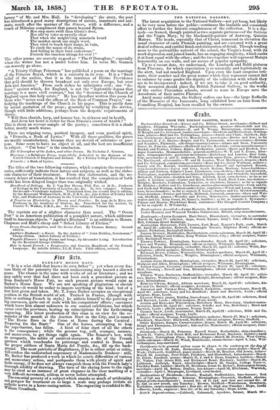THE NATIONAL GALLERY.
The latest acquisition to the National Gallery-not yet hung, but likely to be very soon before the public-continues the laudable and consistent effort to further the historic completeness of the collection. It is a dip- tych-so framed, though painted as two separate pictures-of the Saviour and the Virgin Mary, by the blacksmith-painter of Antwerp, Quintin Matsys. The heads, especially that of Christ, transcend in elevation the usual character of early Flemish painting, and are executed with a great deal of softness, and careful finish and elaboration of detail. Though tending more to the portraitlike naivete of the school, the Virgin's head, with its meek depression and joined hands, has an engaging simplicity, which ranks it at least equal with the other ;_ and the two together will represent Matsys honourably on our walls, and are secure of popular sympathy. Up to a recent date, we understand, the Lombardi and Baldi pictures from Florence, for which expectation is so naturally and legitimately on the alert, had not reached England. Upon even the least sanguine esti- mate, their number and the great names which they represent cannot fail to enhance by some grades the dignity of the collection with which they are to be incorporated : indeed, if we are to take it on good authority, their accession should place the British National Gallery, in the works of the earlier Florentine schools, second to none in Europe save the Accademia of their native Florence.
Amid many additions, the Gallery suffers one loss-the large Raffaelle of the Massacre of the Innocents, long exhibited here on loan from the Foundling Hospital, has been recalled by the owners.


























 Previous page
Previous page